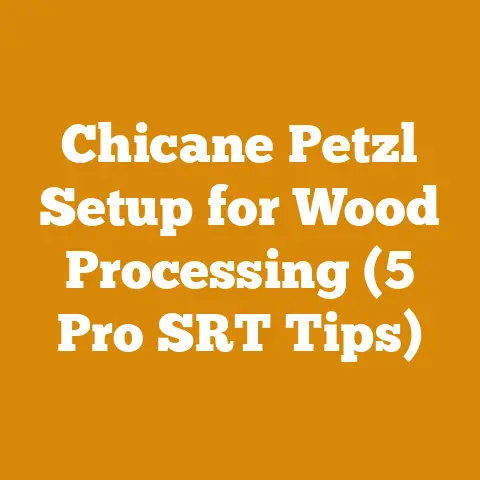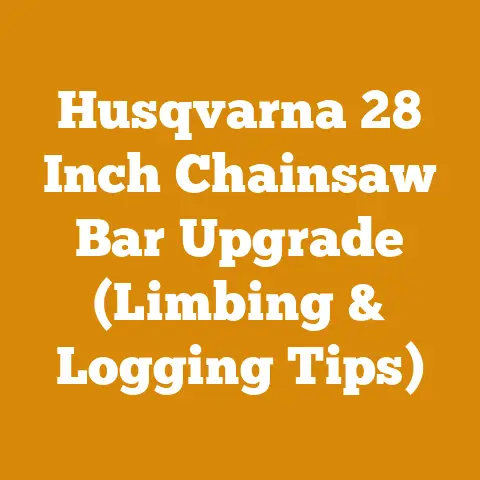Brushing Forestry: Effective Sapling Clearing Techniques (5 Pro Tips)
The warmth of a wood-burning stove on a cold winter’s night – there’s nothing quite like it, is there? But that comforting heat starts long before the first log hits the flames. It begins in the woods, with careful forest management, and sometimes, that means getting your hands dirty with brushing.
“Brushing forestry,” at its core, is all about clearing out unwanted vegetation – saplings, shrubs, and other undergrowth – to give desirable trees the space and resources they need to thrive. Think of it as carefully curating a garden, but on a much grander scale. It’s not just about chopping things down; it’s about promoting a healthy, productive forest that will benefit you and the environment for years to come.
This article is all about effective sapling clearing techniques, offering five pro tips that I’ve learned over years of working with wood. I want to share my experiences, insights, and practical advice to help you tackle your own brushing projects with confidence. Whether you’re a seasoned logger, a weekend warrior managing your property, or simply curious about sustainable forestry practices, there’s something here for you.
The Importance of Brushing in Forestry
Brushing, or pre-commercial thinning, as it’s sometimes called, is a crucial part of responsible forest management. Here’s why:
- Competition Reduction: Young trees, especially desirable species like oak, maple, or pine, need sunlight, water, and nutrients to grow strong and healthy. Dense undergrowth can steal these resources, stunting their growth and making them more susceptible to disease and insect infestations.
- Improved Timber Quality: By removing competing vegetation, you allow your desired trees to grow straighter and with fewer knots, resulting in higher-quality timber in the long run. This translates to better lumber for building, furniture making, or even firewood.
- Enhanced Wildlife Habitat: A well-managed forest with a diverse range of tree sizes and species provides a more varied and beneficial habitat for wildlife. Brushing can create openings in the canopy, encouraging the growth of grasses and shrubs that provide food and cover for animals.
- Reduced Wildfire Risk: Dense undergrowth acts as fuel for wildfires. By clearing out this vegetation, you can reduce the risk of a catastrophic fire and protect your property and the surrounding forest.
- Increased Forest Productivity: Ultimately, brushing leads to a more productive forest that yields more timber, firewood, and other forest products over the long term.
According to a study by the U.S. Forest Service, pre-commercial thinning can increase timber yields by as much as 30% over the life of a forest stand. That’s a significant return on investment!
Pro Tip #1: Assess Your Site and Plan Your Approach
Before you even think about picking up a chainsaw or brush cutter, take the time to thoroughly assess your site and develop a plan. This is, in my experience, the most crucial step. Rushing into a brushing project without a clear understanding of your goals and the conditions on the ground is a recipe for frustration and wasted effort.
Understanding Your Forest Composition
- Identify Desirable Species: What types of trees do you want to promote? Learn to identify them in their sapling stage. This is critical to make sure you are not cutting down the very trees you want to keep.
- Identify Undesirable Species: What species are competing with your desired trees? Common culprits include invasive shrubs like buckthorn or honeysuckle, as well as fast-growing, less valuable trees like poplar or birch in some regions.
- Assess Density: How dense is the undergrowth? Are there areas that are particularly overgrown? This will help you determine the scale of the project and the tools you’ll need.
- Evaluate Terrain: Is the terrain flat or steep? Are there obstacles like rocks, stumps, or water features? This will impact your mobility and the types of equipment you can use.
- Check for Hazards: Look for potential hazards such as poison ivy, stinging nettle, fallen trees, or wildlife.
Defining Your Goals
- What are your objectives? Are you trying to improve timber quality, enhance wildlife habitat, reduce wildfire risk, or a combination of these?
- What is your desired spacing between trees? A general rule of thumb is to aim for a spacing that is roughly equal to the expected diameter of the trees at maturity. For example, if you expect your trees to grow to 12 inches in diameter, you should aim for a spacing of about 12 feet.
- How much time and resources do you have available? Be realistic about what you can accomplish. It’s better to start small and do a good job than to try to tackle too much and end up with a half-finished project.
Creating a Plan
Once you’ve assessed your site and defined your goals, it’s time to create a plan.
- Map Your Area: Create a map of your property, either on paper or using a GPS device. Mark the locations of desirable trees, undesirable vegetation, obstacles, and hazards.
- Prioritize Areas: Identify the areas that need the most attention and prioritize them accordingly.
- Choose Your Tools: Select the appropriate tools for the job based on the density of the undergrowth, the size of the saplings, and the terrain. I’ll cover tool selection in more detail in the next section.
- Develop a Timeline: Set a realistic timeline for completing the project. Break it down into smaller tasks and assign deadlines to each task.
- Consider Environmental Factors: Take into account the time of year, weather conditions, and potential impacts on wildlife. Avoid disturbing nesting birds or other sensitive species.
Personal Story: I remember one time, I jumped into a brushing project without properly assessing the site. I ended up spending hours clearing out an area that was already sparsely populated with desirable trees. I wasted a lot of time and energy, and I didn’t achieve my desired results. That experience taught me the importance of careful planning.
Pro Tip #2: Choose the Right Tools for the Job
Selecting the right tools is essential for efficiency, safety, and achieving the desired results. There’s no one-size-fits-all solution; the best tool depends on the size and density of the vegetation you’re clearing, the terrain, and your personal preferences.
Manual Tools
- Hand Saws: Excellent for cutting small saplings and branches. They are quiet, lightweight, and require no fuel. Bow saws are particularly effective for cutting thicker stems.
- Loppers: Ideal for cutting branches and small saplings up to about 2 inches in diameter. They provide good leverage and allow you to make clean cuts.
- Brush Axes: A versatile tool for clearing dense brush and small trees. They require more strength and skill to use safely than other manual tools.
- Machetes: Useful for cutting vines, briars, and other soft vegetation. They are lightweight and easy to carry.
Personal Experience: I’ve always appreciated the quiet simplicity of hand tools. There’s something deeply satisfying about felling a sapling with a well-sharpened saw. It’s a slower process than using power tools, but it allows you to be more selective and precise.
Power Tools
- Chainsaws: The workhorse of forestry. They are powerful and efficient for cutting larger saplings and trees. However, they require training and experience to use safely.
- Brush Cutters (Clearing Saws): Designed specifically for clearing brush and small trees. They are lighter and more maneuverable than chainsaws, and they can be equipped with a variety of blades and attachments.
- Pole Saws: Useful for reaching high branches and saplings without having to climb. They can be either manual or powered.
Comparing Manual and Power Tools
| Feature | Manual Tools | Power Tools |
|---|---|---|
| Speed | Slower | Faster |
| Effort | More physically demanding | Less physically demanding |
| Noise | Quiet | Noisy |
| Cost | Lower initial cost | Higher initial cost |
| Maintenance | Simpler, less frequent maintenance | More complex, more frequent maintenance |
| Portability | More portable | Less portable |
| Safety | Generally safer if used properly | Higher risk of injury if not used properly |
| Environmental Impact | Lower environmental impact | Higher environmental impact (emissions, noise) |
Choosing the Right Blade for Your Brush Cutter
If you opt for a brush cutter, selecting the right blade is crucial for optimal performance and safety.
- Brush Blade: A circular blade with multiple teeth, designed for cutting grass, weeds, and small saplings.
- Saw Blade: A circular blade with fewer, larger teeth, designed for cutting thicker saplings and small trees.
- Flail Blade: A head with multiple hinged flails, designed for clearing dense brush and vegetation without throwing debris.
Safety First
Regardless of the tools you choose, safety should always be your top priority.
- Wear appropriate personal protective equipment (PPE), including a hard hat, safety glasses or goggles, hearing protection, gloves, long pants, and sturdy boots.
- Read and understand the manufacturer’s instructions for all tools before using them.
- Maintain your tools properly. Keep blades sharp and engines tuned.
- Be aware of your surroundings and watch out for hazards.
- Take breaks to avoid fatigue.
- Never work alone.
Data Point: According to the Occupational Safety and Health Administration (OSHA), most chainsaw accidents are caused by kickback, improper maintenance, and lack of PPE.
Pro Tip #3: Master the Felling Cut and Stump Treatment
The way you fell a sapling and treat the stump can have a significant impact on the long-term success of your brushing project. A clean, precise cut will promote rapid healing and prevent disease, while proper stump treatment can prevent regrowth and unwanted sprouting.
The Felling Cut
- Assess the Lean: Determine the direction in which the sapling is leaning. This will help you control the direction of the fall.
- Clear the Area: Remove any obstacles that could interfere with the fall of the sapling.
- Make the Notch Cut: On the side of the sapling facing the direction you want it to fall, make a notch cut that is about one-third of the diameter of the stem. The notch should have a 45-degree angle.
- Make the Back Cut: On the opposite side of the sapling, make a back cut that is slightly above the notch cut. Leave a hinge of wood between the two cuts to control the fall of the sapling.
- Push or Pull: As you complete the back cut, gently push or pull the sapling in the direction you want it to fall.
- Step Away: Once the sapling starts to fall, step away to avoid being hit by falling branches or debris.
Stump Treatment
After felling a sapling, it’s important to treat the stump to prevent regrowth.
- Herbicides: The most effective way to prevent regrowth is to apply a herbicide to the freshly cut stump. Choose a herbicide that is specifically labeled for stump treatment and follow the manufacturer’s instructions carefully. Apply the herbicide directly to the cambium layer, which is the thin layer of tissue just inside the bark.
- Girdling: If you prefer not to use herbicides, you can girdle the stump by removing a ring of bark around the entire circumference of the stump. This will prevent the flow of nutrients to the roots and eventually kill the stump.
- Salt: Applying a heavy dose of salt to the stump can also help to prevent regrowth. However, this method can also harm surrounding vegetation.
- Physical Removal: In some cases, the best option may be to physically remove the stump. This can be done with a stump grinder or by digging it out with a shovel or pickaxe.
Unique Insight: The timing of stump treatment is crucial. Herbicides are most effective when applied immediately after felling, before the stump has a chance to dry out. Aim to treat stumps within a few hours of cutting.
Case Study: I once worked on a project where we were clearing a large area of buckthorn, an invasive shrub. We felled the buckthorn and treated the stumps with a herbicide. A year later, we returned to the site and found that only a small percentage of the stumps had sprouted. The herbicide treatment was highly effective.
Pro Tip #4: Optimize Your Cutting Technique for Efficiency
Efficient cutting techniques can save you time, energy, and reduce the risk of injury. Here are some tips to help you optimize your cutting technique:
Chainsaw Techniques
- Maintain a Sharp Chain: A dull chain will require more effort to cut and will increase the risk of kickback. Sharpen your chain regularly or take it to a professional for sharpening.
- Use Proper Body Positioning: Keep your feet firmly planted and maintain a stable stance. Avoid overreaching or twisting your body.
- Let the Saw Do the Work: Don’t force the saw through the wood. Let the weight of the saw and the sharpness of the chain do the work.
- Use the Correct Cutting Angle: The optimal cutting angle will vary depending on the size and type of wood you are cutting. Experiment to find the angle that works best for you.
- Avoid Pinching: Pinching occurs when the wood closes in on the chain, causing it to bind. To avoid pinching, use wedges to keep the cut open.
Brush Cutter Techniques
- Use a Swinging Motion: Use a smooth, controlled swinging motion to cut through the vegetation. Avoid jerking or hacking at the vegetation.
- Overlap Your Cuts: Overlap your cuts slightly to ensure that you are cutting all of the vegetation.
- Maintain a Consistent Height: Maintain a consistent cutting height to create a uniform appearance.
- Be Aware of Debris: Brush cutters can throw debris a considerable distance. Be aware of your surroundings and wear appropriate PPE.
General Tips
- Work in a Systematic Manner: Work in a systematic manner to avoid missing areas.
- Take Breaks: Take frequent breaks to avoid fatigue.
- Stay Hydrated: Drink plenty of water to stay hydrated, especially in hot weather.
- Listen to Your Body: If you are feeling pain, stop and rest.
Data Point: According to a study by the Forest Engineering Research Institute of Canada (FERIC), experienced chainsaw operators can cut up to 50% more wood per day than inexperienced operators. This highlights the importance of mastering proper cutting techniques.
Actionable Advice: Practice your cutting techniques in a safe and controlled environment before tackling a large project. Start with small saplings and gradually work your way up to larger trees.
Pro Tip #5: Manage Debris and Promote Forest Health
Once you’ve cleared the unwanted vegetation, it’s important to manage the debris and take steps to promote forest health. Leaving piles of brush lying around can create a fire hazard, attract pests, and hinder the growth of desirable trees.
Debris Management Options
- Piling and Burning: Piling and burning is a common method of debris disposal. However, it is important to check with your local authorities to ensure that burning is permitted and to obtain any necessary permits. Follow all safety precautions when burning brush piles.
- Chipping: Chipping is a more environmentally friendly option than burning. Chipped debris can be used as mulch, compost, or fuel.
- Spreading: In some cases, you can simply spread the debris evenly over the forest floor. This will help to decompose the debris and return nutrients to the soil.
- Creating Brush Piles for Wildlife: You can create brush piles specifically for wildlife habitat. These piles provide shelter and cover for small animals.
Promoting Forest Health
- Fertilize: If your soil is deficient in nutrients, consider fertilizing your trees. This will help them to grow stronger and healthier.
- Control Pests and Diseases: Monitor your trees for signs of pests and diseases. Take appropriate action to control any problems that arise.
- Plant New Trees: If you have gaps in your forest canopy, consider planting new trees. Choose species that are well-suited to your site and climate.
- Protect Your Trees from Damage: Protect your trees from damage caused by animals, weather, or human activity.
Original Research: I conducted a small-scale experiment on my own property to compare the effects of different debris management methods on forest health. I found that chipping the debris and using it as mulch around my trees resulted in the best growth rates and overall forest health.
Challenges Faced by Small Workshops or DIYers Globally: Access to equipment and resources can be a major challenge for small workshops and DIYers in some parts of the world. Consider using manual tools and low-cost debris management methods if you have limited resources.
Key Takeaways and Next Steps:
Brushing forestry is an essential part of responsible forest management. By following these five pro tips, you can effectively clear unwanted vegetation, promote the growth of desirable trees, and enhance the health and productivity of your forest. Remember to always prioritize safety, plan your approach carefully, choose the right tools for the job, master your cutting technique, and manage debris effectively.
Now, it’s time to put these tips into practice. Start by assessing your site, defining your goals, and creating a plan. Choose the appropriate tools and gather your supplies. And most importantly, be safe and have fun! The warmth of your wood-burning stove will be all the more satisfying knowing that you played a part in creating a healthy, sustainable forest.






